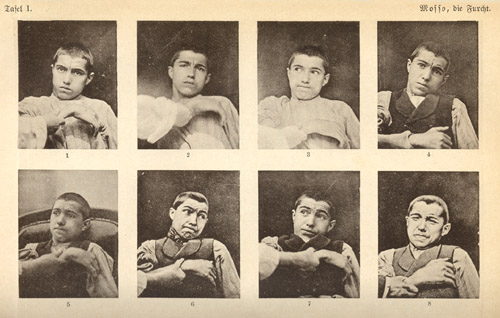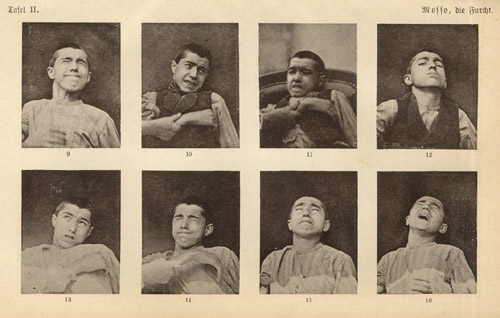

Leipzig : S. Hirzel, 1889.
Description : [6] p., [1]-251 p., [2 l. pl.] ; ill., 7 fig., 2 photo. ; 20.7 cm.
Photographs : 2 collotypes, each with 8 clinical portraits.
Subject : Psychophysiology — Trauma.
Photographer : Angelo Mosso.
Notes :
Important contribution to the field of psychophysiology, specifically the study of somatic innervation of trauma which Mosso tried to differentiate with his plethysmograph, an instrument which he invented for this purpose. Charcot drew from the French translation (Paris: Alcan, 1886) to support his theory of a neurodegenerative predisposition (diathèse) behind the functional disorders that often follow trauma.
The 16 collotypes are reproductions of photos in Mosso's "Pain Album" and portray an 18 year old construction worker who was admitted to the Turin Hospital for a wound in the right elbow that wasn't healing properly. Treatment involved a daily regimen of physical therapy which was documented by Mosso with his remote operated camera. Figures 1 through 4 were taken before the procedure. Figure 5 was taken when the arm was lightly moved, to determine the grade of the debility and the onset of pain. Figure 6 was taken when the forearm was forcibly bent and the patient felt severe pain. Figures 7 through 16 are of subsequent procedures at moments when the pain was most pronounced.


Die Maschine öffnete und schloss sich augenblicklich mittels einer electrischen Vorrichtung,
welche ich eigens zu diesem Zwecke construirt hatte. Ich konnte während der Operation
neben dem Kranken stehen, und indem ich im gegebenen Augenblicke auf einen Lastknopf drückte,
erhielt ich das Bild des Kranken in der Maschine, welche einige Schritte entfernt ausgestellt
war.
Auf diese Weise habe ich eine Art Schmerzensalbum zusammengebracht. Es ist ein trauriges
und furchtbares Buch; die Wirklichkeit kommt darin mit solcher Lebendigkeit zum Ausdrucke,
dass man es nur mit Schaudern öffnet. Keines Künstlers Phantasie hat sich das
vorzustellen oder hat das auszudrücken gewusst, was uns die Photographie nach der Natur
bietet. Das menschlich Gesicht erweckt in den höchsten Graden des Leidens bei dem, der
es betrachtet, Furcht; es ist nicht nur das tiefe Mitgefühl für die Qual eines
empfindenden Wesens, was uns erschüttert, oder die Demüthigung, welche in uns das
Schauspiel des menschlichen Glends erweckt, sondern es ist der egoistische Gedanke, dass jenes
zuckende Fleisch unser Fleisch sein, dass unsere vom Schmerz gepeinigte Seele gleiche Funken
geben könnte und dass die Qual unserer Nerven uns dieselben Thränen, die nämlichen
Schreie erpressen würde.
